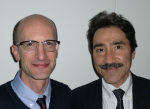ASRM2010: EndoSIG puts endometriosis on the map
Denver, 28 October 2010 | by Lone Hummelshoj
At the 66th Annnual Meeting of the ASRM 1530 abstracts were submitted. Of these, 916 were accepted; nine of those were oral presentations about endometriosis (out of 316), and 27 (out of 600) were poster presentations. In addition there were two key note lectures on endometriosis, a breakfast symposium, an interactive session, and an award.

ASRM EndoSIG
To get endometriosis included in the ASRM programme the way it truly was this year, is one of the missions of the Endometriosis Special Interest Group (EndoSIG) — a group of physicians who are committed to moving the field of endometriosis forward (from left in the photo): Tommaso Falcone (chair elect), Pamela Stratton (chair), Dan Lebovic (immediate past chair), Kathy Sharpe-Timms (past chair), Robert Taylor (founder), (missing is Hugh Taylor).
They succeeded! This year’s annual meeting commenced on the Monday with a breakfast symposium on endometriosis, which was exceptionally well attended, quickly followed that same morning by the Herbert H Thomas Lecture which, this year, was about endometriosis: Professor Serdar Bulun presented on “Steroidogensis in endometriosis” to a room so full of delegates, that many were sitting on the floor and leaning against the walls to squeeze into the room in order to learn more about the challenges of a challenging disease — and potential future treatments…
Later that afternoon, Eline Dancet from Leuven University Hospital won the prize from the Nurses Professional Group for her work in developing a reliable instrument to evaluate the patient-centredness of endometriosis care.

ASRM EndoSIG chair, Dan Lebovic, with ASRM2010 Scientific Programme Chair, Robert Taylor
During the EndoSIG’s oral communications session on Tuesday afternoon excellent papers were presented ranging from diagnostic tools, efficacy of current medical therapies as well as new and emerging medical options.
In order of presentation, the EndoSIG chair, Dan Lebovic, has provided a summary of what was presented:
- The effects of various medical therapies on the volume of rectovaginal nodules concluded that after one year each type of drug did indeed reduce the volume of rectovaginal nodules (Ferrero et al). This same group assessed the utility of MRI enteroclysis imaging compared to rectal water contrast transvaginal ultrasound and found equivalency in accurately diagnosing rectosigmoid endometriosis.
- Utilising an aromatase inhibitor on top of a GnRH analogue was reported to give more efficacious pain relief than GnRH analogue alone (Scarpellini et al).
- Confirming hypotheses of altered pain thresholds in women suffering from endometriosis, a paper described findings of an exaggerated response to pain stimuli in women with chronic pelvic pain and endometriosis (Khachikyan et al).
- Infertile women with stage III/IV endometriosis stage were found to have elevated serum markers of oxidative stress as compared to controls (Donabela et al).
- Further evidence of the utility of an immunomodulatory drug–ciglitazone (PPAR-gamma)–was presented showing its ability to inhibit proliferation and induce apoptosis in endometriotic cell lines (Kavoussi et al).
- Another emerging therapeutic option for endometriosis, simvastatin, was shown to reduce estrogen receptor alpha and beta gene expression (Sokalska).
- The final oral presentation presented elegant results on the utility of retinoic acid for treating endometriosis based on their favorable data using an immunocompetent mouse model of endometriosis (Wieser et al).
The efficacy of Traditional Chinese Medicine (TCM), Lessons from the use of non-human primates, and the launch of the Endometriosis Fertility Index was covered on the Wednesday bringing a lot of treatment concerns to the surface in terms of handling this disease…
Treating endometriosis today, however, remains a challenge with no straight forward solution — but investigating those solutions remain the primary focus of so many dedicated scientists around the world.
Keep up-to-date with progress in endometriosis: twitter.com/endometriosis






